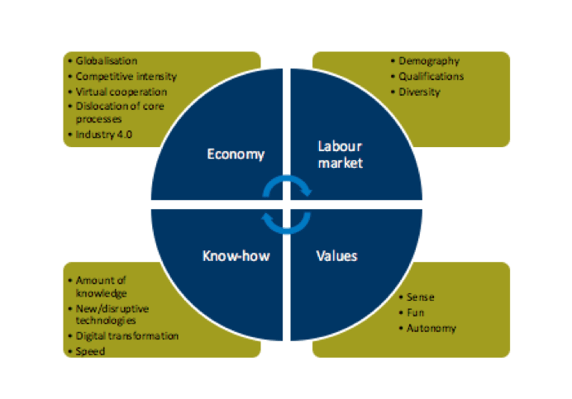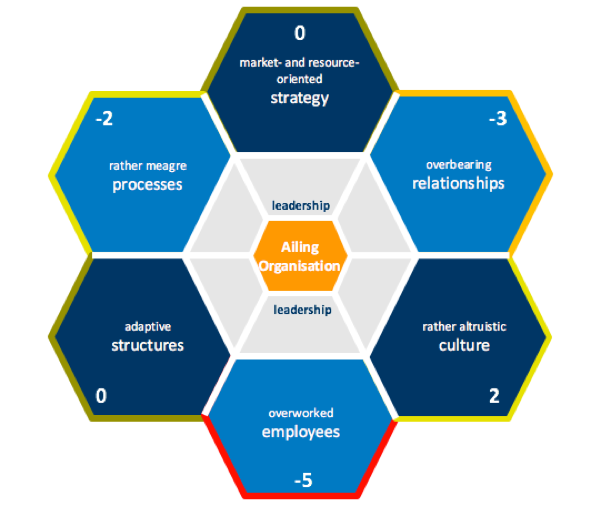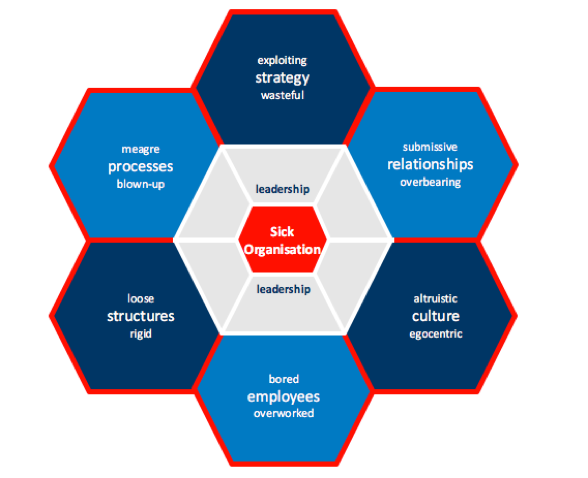The REFLECT series on the "Sick Organisation" (SO 1/7)
After we have unfolded our concepts of the Healthy Organisation (2014) and Leadership in the Healthy Organisation (2015) over the last two years, we would like to focus on the Sick Organisation (SO) and its smaller sister the Ailing Organisation (AO) in this year’s series, as we have already announced in our last notes. It is less fun, since one rather spends time with positive things, nevertheless the reality of the business world often looks different. In this series we would like to give an idea of what goes wrong in organizations, which causes this might have, and which solutions present themselves.
Four driving forces from the fields of economics, job market, know-how and values can be defined as significant factors influencing the company context (see fig. 1).

Fig. 1: driving forces of the current company context
They mutually influence one another, as suggested by the arrows in the center of the figure. It is not always easy to simultaneously do justice to all of these challenges. For example it is becoming increasingly difficult for people in increasingly complex working worlds, in times ofglobalisation and “virtual“ cooperation, to find meaning in their work. Or: The high level ofcompetitiveness leads to a seemingly more cost-efficient reallocation of core processes, which entails problems in terms of time (complicated processes, language barriers, working in different time zones slows down the total system) and often has negative effects on the fun at work. Or: thehigh amount of knowledge with simultaneous demographic change leads to extreme challenges in how the necessary knowledge can be maintained in the company (keyword “knowledge management“).
Typically enough, the factors altering the competitiveness nowadays are summarized under the acronym VUCA (see fig. 2).
 Fig. 2: VUCA-Matrix (following Bennett & Lemoine, 2014)
Fig. 2: VUCA-Matrix (following Bennett & Lemoine, 2014)
Since unlike earlier times all factors of the business environment are becoming more complex,dynamic, insecure and ambiguous, more possibilities and chances are also arising. Therefore, Fredmund Malik (2015) does not predict for nothing that the handling of complexity will belong to the prominent skills of executives with regard to the successful controlling of organisations in the 21st century. But not yet all see complexity, volatility, ambiguity and uncertainties actually as a chance, but rather as a threat. The common mechanism of control, as they have been practiced up until the last century, work for better or worse and will work less and less in the future.
The result are Ailing or Sick Organisations. What do we mean by this?
We speak of an Ailing Organisation (AO) when not the entire organism is infected by a disease but only parts, just like a living organism. According to our logic of the HO, this involves the fields of leadership, strategy, relations, culture, employees, structures and processes.
For the sake of explanation let’s hold onto the metaphor of the human organism: if a part of the organism is infected e.g. by a virus, then the human is ailing. If the immune system is intact and the human rests and watches his nutrition, then he will be back on his feet . The organism heals itself and puts itself in balance. This is similar for companies: even ailing companies can overcome crises by themselves, if they pause and make themselves aware of their resources. On the other side, organisms infected by a virus can be quite successful for some years without showing it. There are numerous current examples, just consider VW (rigid hierarchies, dictatorship, culture based on fear).
If one doesn’t take those ailing symptoms seriously enough and carries on as usual, the organism can become seriously ill, in the worst case even incurably. The same is true for organisations. As a current example consider the case of the Deutsche Bank. Over many years they betrayed in different corporate divisions and one scandal followed the next. “Cleaning up“ was the motto, but it hasn’t really worked out so far. The same as with the organism, only radical rethinking and doing-it-differently can help the company to recover. Whether this will be successful with the new strong man at the top - John Cryan and his radical group restructuring - remains to be seen. However, hope always dies last.
The following 3 illustrations show an AO. In the case shown the company has a market- and resource-oriented strategy and adaptive structures, which is indicated by the dark green marking on the outside of the honeycomb and the figure 0. However, the employees are underconstant stress (red marking, -5), under which relations suffer as well (orange marking, -3). Reasons for this could be possibly the rather meagre processes (light green, -2) or also the ratheraltruistic culture (light green, +2), in which the employees sacrifice themselves for the organisation. Both extreme forms in direction -5 and +5 we see as exaggerations and thus as unhealthy. For a better understanding we have faded out the influence of leadership as an independent field to begin with, since we will come back to this subject in one of our future Notes.

Fig. 3: Example of an Ailing Organisation AO (without leadership dimensions - marked as a grey field in the middle)
This representation method allows on the one hand an overview of the total situation but also insights into the condition of the individual dimensions. We presume that the balance between the individual dimensions in the long term represents the optimal condition for a successful organisation. Under balance we understand in this connection that the individual dimensions, but also the total organisation and the type of leadership, across a longer period of time should neither tend towards the one or the other direction too much.
With a Sick Organisation (SO) almost all or even all organisation dimensions are infected with the pathogens. This completely unbalances a SO, leaving it without a chance to compensate its weak points and symptoms with strong points in other dimensions. Usually, it needs help from the outside, e.g. by means of capital injections(Commerzbank), new employees - usually on top management level (Deutsche Bank), restructuring (Kaufhof) or completely new reorientation (EnBW, RWE). Often diverse measures must be taken simultaneously. In the worst case, it’s theend for the SO (Schlecker).
Figure 4 illustrates a KO. The extremes in the individual honeycombs describe the respective possible symptoms and conditions. In their interdependence these lead to a KO which is strongly endangered and in this form no longer sustainable.

Fig. 4: Sick Organisation SO (without leadership dimensions - marked as a grey field in the middle)
This addresses two further aspects: a healthy balance not only refers to the INTRAdimensionallevel, meaning everything that happens within a honeycomb, but also on the INTERdimensionallevel, thus on the interaction between the individual dimensions.
On the intradimensional level balanced company dimensions do not tend extremely towards one direction (e.g. bored - overworked, egocentric - altruistic, loose - rigid), but in the best case are located in the middle between both poles. Therefore, it must be the goal to establish a intradimensional balance, that will lie between the two extremes - e.g. in the case of the employees between bored and overworked. That is what defines capable employees.
As we briefly mentioned above, the interdimensional level also plays a role. Due to the interdependencies and reciprocal influences a change in one dimension can have influence on another dimension. Let’s suppose a company experiences a serious crisis and the top management decides to dismiss employees as a bitter but necessary fast and effective measure. Of course, such news trigger immediate concernment, fear, uncertainty and stress. But this will not remain the only symptom. Such a decision will lead to changes in all company dimensions and cause a snowball effect which one might not always be completely aware of.
Therefore, it is of crucial importance to understand the systemic character of organisations. Thus, the goal cannot merely be to achieve an intradimensional balance. This will hardly be manageable if seen in an isolated way. The interdimensional balance is the more important and simultaneously the more fundamental challenge. It has a more sustainable effect, secures the intradimensional balance and consequently an overall more balanced company that is future-proof and dynamically solid.
In the following notes of this series we will point out the dimensional characteristics of an AO and SO, in order to clarify (early) indicators, that you can use for an analysis and an idea generation for your organisation. Furthermore, concrete practical examples will illustrate the subject.

